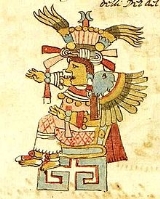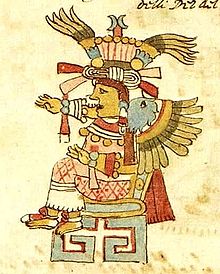
Xochiquetzal
Encyclopedia

Aztec mythology
The aztec civilization recognized a polytheistic mythology, which contained the many deities and supernatural creatures from their religious beliefs. "orlando"- History :...
, Xochiquetzal (ʃotʃiˈketsaɬ) was a goddess associated with concepts of fertility, beauty, and female sexual power, serving as a protector of young mothers and a patroness of pregnancy, childbirth, and the crafts practised by women such as weaving and embroidery. Unlike several other figures in the complex of Aztec female earth deities connected with agricultural and sexual fecundity, Xochiquetzal is always depicted as an alluring and youthful woman, richly attired and symbolically associated with vegetation and in particular flowers. By connotation, Xochiquetzal is also representative of human desire, pleasure, and excess, appearing also as patroness of prostitutes and artisans involved in the manufacture of luxury items.
She was followed by a retinue consisting of birds and butterflies
Butterfly
A butterfly is a mainly day-flying insect of the order Lepidoptera, which includes the butterflies and moths. Like other holometabolous insects, the butterfly's life cycle consists of four parts: egg, larva, pupa and adult. Most species are diurnal. Butterflies have large, often brightly coloured...
. Worshippers wore animal and flower masks at a festival, held in her honor every eight years.
Her twin was Xochipilli
Xochipilli
thumb|300px|right| Image of Xochipilli.Xochipilli was the god of art, games, beauty, dance, flowers, and song in Aztec mythology. His name contains the Nahuatl words xochitl and pilli , and hence means "flower prince"...
and her husband was Tlaloc
Tlaloc
Tlaloc was an important deity in Aztec religion, a god of rain, fertility, and water. He was a beneficent god who gave life and sustenance, but he was also feared for his ability to send hail, thunder and lightning, and for being the lord of the powerful element of water. In Aztec iconography he...
, until Tezcatlipoca
Tezcatlipoca
Tezcatlipoca was a central deity in Aztec religion. One of the four sons of Ometeotl, he is associated with a wide range of concepts, including the night sky, the night winds, hurricanes, the north, the earth, obsidian, enmity, discord, rulership, divination, temptation, jaguars, sorcery, beauty,...
kidnapped her and she was forced to marry him. At one point, she was also married to Centeotl
Centeotl
thumb|300px|right|Image of Centeotl, the Aztec God of Maize.In Aztec mythology, Centeotl is the masculine deity of maize....
and Ixotecuhtli. By Mixcoatl
Mixcoatl
Mixcoatl , or Camaxtli, was the god of the hunt and identified with the Milky Way, the stars, and the heavens in several Mesoamerican cultures. He was the patron deity of the Otomi, the Chichimecs, and several groups that claimed descent from the Chichimecs...
, she was the mother of Quetzalcoatl
Quetzalcoatl
Quetzalcoatl is a Mesoamerican deity whose name comes from the Nahuatl language and has the meaning of "feathered serpent". The worship of a feathered serpent deity is first documented in Teotihuacan in the first century BCE or first century CE...
.
Anthropologist Hugo Nutini identifies her with the Virgin of Ocotlan
Virgin of Ocotlan
The Virgin of Ocotlán is statue of the Virgin Mary in Ocotlán, Tlaxcala, Mexico. The Virgin of Ocotlán is the patron saint of Tlaxcala and the neighbouring state of Puebla.-The Legend:...
in his article on patron saints in Tlaxcala
Tlaxcala
Tlaxcala officially Estado Libre y Soberano de Tlaxcala is one of the 31 states which along with the Federal District comprise the 32 federative entities of Mexico. It is divided into 60 municipalities and its capital city is Tlaxcala....
.
In pre-Hispanic Maya culture, a similar figure is Goddess I
Goddess I
Goddess I is the Schellhas-Zimmermann-Taube letter designation for one of the most important Maya deities: a youthful woman to whom considerable parts of the post-Classic codices are dedicated, and who equally figures in Classic Period scenes...
.

